 Last additions - Minato-ku 港区 Last additions - Minato-ku 港区 |

Apr 05, 2010
|
|

Cherry blossom tunnel at Aoyama Cemetery.Apr 05, 2010
|
|

Apr 05, 2010
|
|

Main thoroughfare, lined with cherry trees, cuts through the middle of the cemetery where cars whiz by. Quite irritating.Apr 05, 2010
|
|

Main entrance to Aoyama Cemetery during cherry blossom season in early April. Gaienmae Station (Ginza/Hanzomon Line) and Nogizaka Station (Chiyoda Line) are the closest subway stations.Apr 05, 2010
|
|

After the bean throwing, lots of people lined up to obtain good-fortune beans or fukumame. 福豆Feb 24, 2010
|
|

Feb 24, 2010
|
|

As people ran out of beans, they left the terrace. The bean throwing was over in 10 min. or so.Feb 24, 2010
|
|

Ohbayashi MotokoFeb 24, 2010
|
|

Feb 24, 2010
|
|

Ohbayashi Motoko, former Olympic volleyball player serving as a setsubun bean thrower at Toyokawa Inari Tokyo Betsuin temple on Feb. 3, 2010.Feb 24, 2010
|
|

Feb 24, 2010
|
|

Feb 24, 2010
|
|

They were hardly able to throw the beans too far, so you had to be up front to catch the beans. Those of us in the back could hardly catch any beans.Feb 24, 2010
|
|

Kataoka Shinwa, actor, throwing beans for setsubun at Toyokawa Inari Tokyo Betsuin. 片岡信和Feb 24, 2010
|
|

Feb 24, 2010
|
|

Feb 24, 2010
|
|

Feb 24, 2010
|
|

Feb 24, 2010
|
|

Feb 24, 2010
|
|

Feb 24, 2010
|
|

Feb 24, 2010
|
|

Feb 24, 2010
|
|

Feb 24, 2010
|
|

Feb 24, 2010
|
|

Feb 24, 2010
|
|

The bean throwing begins. The space is not as big as Zojoji temple (also in Minato-ku). They threw individual beans instead of bags of beans. It makes it harder to catch and makes a mess on the ground.Feb 24, 2010
|
|

Hokuyo comedians 北陽Feb 24, 2010
|
|

All the celebrity bean throwers introduced themselves. Arimura Miki. 有村実樹Feb 24, 2010
|
|

Tetsu and TomoFeb 24, 2010
|
|

Lots of music since the temple also worships Benzaiten who is also a goddess of music.Feb 24, 2010
|
|

Kataoka Shinwa, actor. 片岡信和Feb 24, 2010
|
|

Feb 24, 2010
|
|

Temple priest says a few words. Feb 24, 2010
|
|

Ohbayashi Motoko, former Olympic volleyball player serving as a setsubun bean thrower at Toyokawa Inari Tokyo Betsuin temple on Feb. 3, 2010.Feb 24, 2010
|
|

In the middle is Ohbayashi Motoko, former Olympic volleyball player. She was a bean thrower in 2007 here too.Feb 24, 2010
|
|

Feb. 3 is Setsubun when many temples and shrines hold a mamemaki bean-throwing ceremony. The Toyokawa Inari Tokyo Betsuin is one temple worshipped by major sports and entertainment figures.Feb 24, 2010
|
|

The bean throwers on the terrace of the Toyokawa Inari Kaikan hall. It started at about 2 pm.Feb 24, 2010
|
|

Sanmon Gate. The Toyokawa Inari Tokyo Betsuin temple is one temple in Tokyo where you can see celebrities throw beans on Feb. 3.Feb 24, 2010
|
|

The fox is the messenger of Inari.Feb 24, 2010
|
|

Honden main hall of Toyokawa Inari Tokyo Betsuin, a Zen Buddhist (Soto) branch temple of Toyokawa Inari temple in Toyokawa, Aichi Prefecture. Near Akasaka Mitsuke and Nagatacho subway stations.Feb 24, 2010
|
|

Grave of Yoshida Shigeru, Japan's first postwar prime minister.Feb 12, 2008
|
|

Grave of loyal dog Hachiko and his master, Professor Ueno.Feb 12, 2008
|
|

Grave of Yoshida Shigeru 吉田茂の墓Feb 12, 2008
|
|

Grave of the family of Robert Walker Irwin (1844-1925), Hawaiian Minister to Japan. (Iron gate has since been removed.)Feb 12, 2008
|
|

Graves of Robert Walker Irwin (rear, on the right) and his family. (Old photos of the graves.)Feb 12, 2008
|
|

Grave of Edoardo Chiossone (1833-1898), an Italian who introduced printing technology (for money and stamps) to Japan. He loved Japan and amassed a huge collection of Japanese art, especially woodblock prints. The collection is donated to a Genova museum.Feb 12, 2008
|
|

Grave of Joseph HecoFeb 12, 2008
|
|

Gravestone of Edoardo ChiossoneFeb 12, 2008
|
|

Grave of Joseph Heco who was born Japanese (as Hamada Hikozo) but naturalized as a US citizen.Feb 12, 2008
|
|

Foreigner's Cemetery 外国人墓地Feb 12, 2008
|
|

A monument erected in March 2007 by Tokyo Governor Ishihara Shintaro in appreciation of the foreigners who helped build Japan.Feb 12, 2008
|
|

List of foreigners buried in this Foreigner's Cemetery. Note that there also other foreigners buried in other parts of Aoyama Cemetery.Feb 12, 2008
|
|

Foreigner's Cemetery 外国人墓地Feb 12, 2008
|
|

This is the Foreigner's Cemetery where many foreigners who helped to modernize Japan are buried.Feb 12, 2008
|
|

Aoyama Cemetery map. Quite complicated system to find grave plots.Feb 12, 2008
|
|

Signs tell you where you are. Quite bewildering mapping system.Feb 12, 2008
|
|

Aoyama Cemetery has over 123,000 graves occupying 125,000 square meters within the cemetery land area of 263,564 sq. meters.Feb 12, 2008
|
|

Aoyama Cemetery office near the main entrance where you can obtain a map of the cemetery and ask where particular people are buried. The maps they provide do not show where the most famous people are (such as prime ministers).Feb 12, 2008
|
|
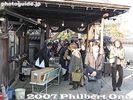
At the gate to enter the graves of the 47 ronin, they sell incense sticks. 四十七士墓所の門Feb 04, 2008
|
|

After reporting to their lord, the group leaves the temple.Feb 03, 2008
|
|
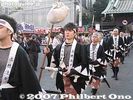
Feb 03, 2008
|
|
|

Leader of the 47 ronin, Oishi Kuranosuke goes in front of the Hondo hall and reported their successful capture of Kira.Feb 03, 2008
|
|
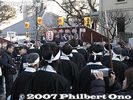
Heading to their lord's grave.Feb 03, 2008
|
|

The Gishisai on Dec. 14 marks the day when the 47 loyal retainers attacked and beheaded Kira to avenge their master (Lord Asano) in 1702. They then marched to Sengakuji to present the head to their master's grave. This is reenacted annually.Feb 03, 2008
|
|
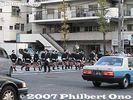
They cross the street full of cars. A Gishisai Festival is also held in Ako in Hyogo Prefecture.Feb 03, 2008
|
|

Statue of Oishi Kuranosuke, leader of the 47 loyal retainers. He's looking (glaring) east toward Edo. The temple grounds also have the Ako Samurai Memorial Hall and the well where they washed Kira's head.Feb 03, 2008
|
|
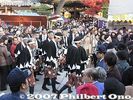
The 47 masterless samurai then proceed to the nearby grave of their Lord Asano.Feb 03, 2008
|
|
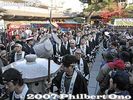
Gishisai on Dec. 14: Headed by Oishi Kuranosuke, the 47 loyal retainers arrive Sengakuji temple.Feb 03, 2008
|
|

The gravestones all look alike. There is a map showing who is buried where.Feb 03, 2008
|
|
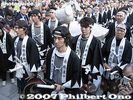
Gishisai: Kira's head strung on a spear is brought to Sengakuji temple.Feb 03, 2008
|
|

Feb 03, 2008
|
|
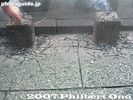
Worshippers pile on the incenseFeb 03, 2008
|
|
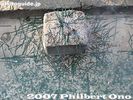
Pile of incense in front of a grave.Feb 03, 2008
|
|

Feb 03, 2008
|
|
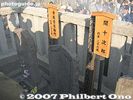
Names are clearly written on wooden plaques.Feb 03, 2008
|
|

Oishi Kuranosuke's graveFeb 03, 2008
|
|

Soon after the 47 retainers committed seppuku on Feb. 4, 1703, they were buried here.Feb 03, 2008
|
|

People buy incense sticks at the gravesite gate and place incense at all the graves.Feb 03, 2008
|
|

Very thick smoke, but not suffocating. People with asthma or lung problems might want to avoid this.Feb 03, 2008
|
|

The smoke can kill all the bugs in your fur or wool coat.Feb 03, 2008
|
|
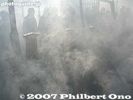
On the Gishisai day or anniversary of the attack on Kira, there is an extra amount of people and incense smoke.Feb 03, 2008
|
|
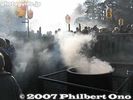
Incense burnerFeb 03, 2008
|
|
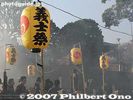
Gishisai lanterns.Feb 03, 2008
|
|

The graves all have headstones with the loyal retainer's name on it and age at death.Feb 03, 2008
|
|

Large way going to the graves of the 47 ronin masterless samurai at Sengakuji temple. 四十七士墓所Feb 03, 2008
|
|
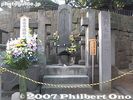
Grave of Lord Asano Naganori (Takumi-no-kami) (1667-1701) of Ako Province.Feb 03, 2008
|
|
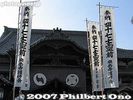
Since it was during the Gishisai Festival on Dec. 14, banners are in front of the Hondo hall for the 47 loyal retainers of Ako. Read about it here.Feb 03, 2008
|
|

Asano clan graveFeb 03, 2008
|
|
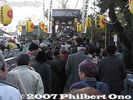
During the Gishisai Festival in mid-Dec., the temple is especially crowded. This is the long line to enter the graves of the 47 loyal samurai retainers. The gravesite's gate up ahead was the back gate of the Ako estate in Tokyo. Later moved here.Feb 03, 2008
|
|
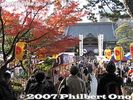
Path to the Hondo temple hall. 本堂Feb 03, 2008
|
|
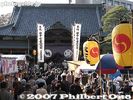
Hondo temple hall. The original hall was destroyed during World War II. Reconstructed in 1953 in the Kamakura style. 本堂Feb 03, 2008
|
|

After the Chumon is the Sanmon Gate which is the temple's main gate. Reconstructed in 1832. 山門Feb 03, 2008
|
|
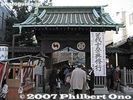
First built by Tokugawa Ieyasu in 1612, Sengakuji temple belongs to the Zen Soto sect. This is the Chumon Gate, facing the south, the first gate most people pass through to enter Sengakuji temple. Reconstructed in 1836. 中門Feb 03, 2008
|
|

Dec 11, 2007
|
|

Dec 11, 2007
|
|

Dec 11, 2007
|
|

Dec 11, 2007
|
|

Nakashima islandDec 11, 2007
|
|

Bridge to Nakashima islandDec 11, 2007
|
|

World Trade Center in Hamamatsucho overlooked the garden. World Trade Center Building (世界貿易センタービル) in Hamamatsuchō was a 40-story commercial skyscraper. It was once Japan's tallest building in 1970.The building closed for good on June 30, 2021 and was torn down during Aug. 2021 to March 2023. The building will be replaced with a new World Trade Center building to be completed in March 2027.Dec 11, 2007
|
|

Stone monumentsDec 11, 2007
|
|

Dry waterfallDec 11, 2007
|
|

Dec 11, 2007
|
|

Dec 11, 2007
|
|

Yukimi Stone LanternDec 11, 2007
|
|

Dec 11, 2007
|
|

Dec 11, 2007
|
|

Bracing a pine tree for winter snow.Dec 11, 2007
|
|

Koi carp fishDec 11, 2007
|
|

Dec 11, 2007
|
|

Dec 11, 2007
|
|

Dec 11, 2007
|
|

Dec 11, 2007
|
|

Dec 11, 2007
|
|

Dec 11, 2007
|
|

Pine trees and pondDec 11, 2007
|
|

The buildings were destroyed in the Kanto Earthquake in 1923 and the property was donated to Tokyo in 1924 to commemorate the start of Emperor Showa's reign.Dec 11, 2007
|
|

Bird's eye view of Kyu-Shiba Rikyu Gardens as seen from Hamamatsu World Trade CenterDec 11, 2007
|
|

Kyu-Shiba-rikyu was first built in the 17th century and used as the residence of a number of nobles. Purchased from the Arisugawa family in 1875 by the Imperial Household Agency which made it the Shiba Detached Palace.Dec 11, 2007
|
|

Entrance to Kyu-Shiba Rikyu Gardens, a real oasis in an urban jungle. Another waterfront garden with classic Japanese-style elements with a pond, pine trees, rocks, and stone lanterns. Dec 11, 2007
|
|
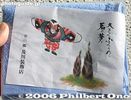
Hand towel which fell onto my chest while I was not watching.Feb 19, 2006
|
|

Bagged a bag of beans, to ward off bad luck and welcome good luck this year.Feb 19, 2006
|
|

My mochi catch: For good fortune this year.Feb 19, 2006
|
|

Elevator hall to go up the towerThe stairway is also available up to the main observatory.Feb 19, 2006
|
|

Feb 19, 2006
|
|
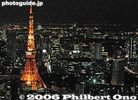
View from Roppongi Hills.Feb 19, 2006
|
|

Main observatoryFeb 19, 2006
|
|

View down from a glass floor on main observatoryFeb 19, 2006
|
|

Main observatoryFeb 19, 2006
|
|

Main observatoryFeb 19, 2006
|
|

Feb 19, 2006
|
|

Special observatory (250 m high). When the wind blows, it sways.Feb 19, 2006
|
|

Feb 19, 2006
|
|

Hama-rikyu GardenFeb 19, 2006
|
|

Feb 19, 2006
|
|

Feb 19, 2006
|
|

Too hazy to see Mt. FujiFeb 19, 2006
|
|

Roppongi Hills at centerFeb 19, 2006
|
|

Feb 19, 2006
|
|

Feb 19, 2006
|
|

Zojoji TempleFeb 19, 2006
|
|

View of Hamamatsu-choFeb 19, 2006
|
|

Memorial to the dogs who served in Antartica.Feb 19, 2006
|
|

Foot of towerFeb 19, 2006
|
|

Main observatoryFeb 19, 2006
|
|

Foot of towerFeb 19, 2006
|
|

Feb 19, 2006
|
|

Tokyo TowerFeb 19, 2006
|
|

Feb 19, 2006
|
|

Tokyo Tower in the daytime.Feb 19, 2006
|
|

Somon Gate 惣門Feb 19, 2006
|
|

Somon Gate 惣門Feb 19, 2006
|
|

Kyozo 経蔵Storehouse for sutra texts. Originally built in 1613 with the financial aid of Tokugawa Ieyasu and renovated and relocated here in 1800. It has an octagonal-shaped with revolving bookshelves in the center.Feb 19, 2006
|
|
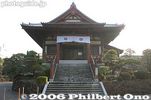
Jiunkaku 慈雲閣Feb 19, 2006
|
|

Feb 19, 2006
|
|

Feb 19, 2006
|
|

Mausoleum of Tokugawa Shoguns 徳川将軍家墓所After Tokugawa Ieyasu started to rule the Kanto region, he designated Zojoji as the family temple of the Tokugawa clan. The Mausoleum has the tombs of six Tokugawa Shoguns (the 2nd shogun Hidetada, 6th shogun Ienobu, 7th shogun Ietsugu, 9th shogun Ieshige, 12th shogun Ieyoshi, and 14th shogun Iemochi), Imperial Princess Kazunomiya (wife of Shogun Iemochi), and wives and children of shoguns. A total of 38 people are buried here.Feb 19, 2006
|
|

Feb 19, 2006
|
|

Feb 19, 2006
|
|

Entrance to Jizo statuesFeb 19, 2006
|
|

Jizo statuesFeb 19, 2006
|
|

Somon Gate 惣門Feb 19, 2006
|
|

Tomb in the Mausoleum of Tokugawa Shoguns before it was open for public viewing.Feb 19, 2006
|
|

Inside the old Ankokuden 安国殿Feb 19, 2006
|
|

Inside old Ankokuden. A picture of Yokozuna Taiho from the 1960s. I wonder why they had it there. 安国殿Feb 19, 2006
|
|

Inside the old Ankokuden 安国殿Feb 19, 2006
|
|

Feb 19, 2006
|
|

Inside old Ankokuden 安国殿Feb 19, 2006
|
|

Security detail. There was a good number of policemen and security people, mainly to discourage pickpockets. Feb 19, 2006
|
|

Main hallFeb 19, 2006
|
|

The old Ankokuden 安国殿Feb 19, 2006
|
|

Should I pick it up from the ground?Feb 19, 2006
|
|

Missed bean bags on groundFeb 19, 2006
|
|

Feb 19, 2006
|
|

For people on the leftFeb 19, 2006
|
|

OoohhhFeb 19, 2006
|
|

Feb 19, 2006
|
|

Feb 19, 2006
|
|

All handsFeb 19, 2006
|
|
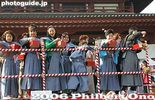
Feb 19, 2006
|
|

Priest and Fukuhara Ai (table tennis player)Feb 19, 2006
|
|

Tamao-chan, Ai-chan, and TochiazumaNakamura Tamao (actress), Fukuhara Ai (table tennis player) and Ozeki Tochiazuma (sumo wrestler)Feb 19, 2006
|
|

People pushing and shoving. Pretty dangerous...Feb 19, 2006
|
|
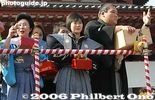
Tamao-chan, Ai-chan, and TochiazumaFeb 19, 2006
|
|

Actress Nakamura Tamao ("Tamao-chan") and TV personality Françoise Moréchand.Here's a Japanese list of the celebrities who threw beans this day:
フランソワ・モレシャン(タレント)、中島 ゆたか(タレント)、川原 多美子(モデル)、秋本 裕希(モデル)、山内 麻美(モデル)、玉川 スミ(落語家)、池田 綾子(歌手)、三笑亭 可楽(落語家)、春風亭 小柳枝(落語家)、三笑亭 夢太朗(落語家)、桂 米助(落語家)、柳亭 楽輔(落語家)、春風亭 鯉昇(落語家)、翁屋 喜楽(落語家)、鏡味 健二郎(太神楽)、神田 ひまわり(講談)、金原亭 伯楽(落語家)、吉原 朝馬(落語家)、金原亭 馬生(落語家)、金原亭 世之介(落語家)、初音家 左橋(落語家)、金原亭 小駒(落語家)、市山 松扇(歌舞伎舞踊)、市山 松翁(歌舞伎舞踊)、市山 松之助(歌舞伎舞踊)、市山 扇之助(歌舞伎舞踊)、市山 竹紫郎(歌舞伎舞踊)、市山 竹松(歌舞伎舞踊)、市山 翔(歌舞伎舞踊)Feb 19, 2006
|
|
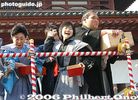
Setsubun bean throwing at Zojoji Temple in Tokyo with Tamao-chan, Ai-chan, and TochiazumaAi-chan was really cute and seemed to be having a great time throwing the beans. Nakamura Tamao (actress), Fukuhara Ai (table tennis player) and Ozeki Tochiazuma (sumo wrestler)Feb 19, 2006
|
|

People on the right wait for the main event...Feb 19, 2006
|
|
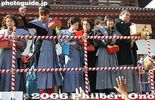
12:30 pm: Celebrity bean throwers 豆まきHeaded by Nakamura Tamao (actress), Fukuhara Ai (table tennis player) and Ozeki Tochiazuma (sumo wrestler), a large number of famous people did the honors.
Here's a Japanese list of the celebrities who threw beans this day:
栃東 関(角界)、福原 愛(女子卓球)、渡部 絵美(元フィギュアスケート選手)、大塚 文雄(民謡歌手)、川野 太郎(俳優)、大谷 晋二郎(プロレスラー)、佐藤 耕平(プロレスラー)、日高 郁人(プロレスラー)、藤田 ミノル(プロレスラー)、大至 伸行(歌手)、水谷 八重子(女優)、川田 公子(みやらび太鼓)、すずき 円香(歌手)、桂 小金治(落語家)、パンツェッタ・ジローラモ(タレント)、武田 幸三(キックボクサー)、わたせ せいぞう(漫画家)、山野愛子ジェーン(山野学苑校長)、中村 玉緒(女優)、岡田 茉莉子(女優)、松旭斉 八重子(マジシャン)、中野 俊彦(松旭斉さん共演)、Feb 19, 2006
|
|

12:15 am: Devil out! Fortune come in! Kindergarten kids throw beans at an orge to drive out evil and bring in good fortune. 鬼問答Feb 19, 2006
|
|

People on the left wait for the main event...Feb 19, 2006
|
|

Bean throwing 節分追儺式First they had people born in the year of the dog throwing small bags of soybeans. They also had one person in a candybox outfit to advertise one of the sponsors who supplied some of the treats they threw to us. Zojoji threw not only beans, but all kinds of little things like tissue paper, towels, toys, potato chips, and candy.Feb 19, 2006
|
|

People behind wait for the main event...Feb 19, 2006
|
|

Feb 19, 2006
|
|

Feb 19, 2006
|
|

Catch of the day...Feb 19, 2006
|
|

Their year in 2006.Feb 19, 2006
|
|

11:45 am: Mochi pounding 餅つきFeb 19, 2006
|
|

Mochi throwingFeb 19, 2006
|
|

Zojoji Head priestFeb 19, 2006
|
|

Children from the neighboring kindergarten.Feb 19, 2006
|
|

People born in the year of the dog.Feb 19, 2006
|
|

Children from the neighboring kindergarten.Feb 19, 2006
|
|

Feb 19, 2006
|
|

Children from the neighboring kindergarten.Feb 19, 2006
|
|

Feb 19, 2006
|
|

Lastly is the ryuteki flute-like gagaku instrument. It makes a long, whining sound. 龍笛Feb 19, 2006
|
|

Feb 19, 2006
|
|

Closeup of the gagaku instrument "sho." 笙Gagaku music is commonly associated with the Shinto religion. However, this Buddhist temple has been playing gagaku since long ago. The sho is a wind instrument making that long, drawling, ghostly haunting sound.Feb 19, 2006
|
|

Two men playing a gagaku instrument called "sho." 笙Gagaku music is commonly associated with the Shinto religion. However, this Buddhist temple has been playing gagaku since long ago.Feb 19, 2006
|
|

Next is the hichiriki, another gagaku instrument. The hichiriki makes a prolonged duck-call sound. 篳篥Feb 19, 2006
|
|

On Feb. 3, 2006, went to see Setsubun bean throwing at Zojoji. Daiden (Hondo) main hall as we wait for the beansI was at the front and center. A good place to catch beans, but not very good for picture taking.
大殿Feb 19, 2006
|
|

Ever since 1958 when Tokyo Tower was built, you could not photograph Zojoji without the tower.Feb 19, 2006
|
|

11:45 am: Procession お練りA long procession of priests, children, and people born in the year of the dog (2006 was the year of the dog) were in the parade.
お練り 午前11時45分〜 開山堂〜三門〜安国殿
餅つき 午後11時55分〜 於:特設舞台
祈 願 午後12時05分〜 於:安国殿
鬼問答 午後12時15分〜 於:特設舞台
豆まき 午後12時30分〜 於:特設舞台
大〆め 午後12時50分〜 於:特設舞台Feb 19, 2006
|
|

Procession of priests.Feb 19, 2006
|
|

Zojoji, Daiden (Hondo) main hall with bean-throwing stage for Setsubun on Feb. 3. 大殿Daiden (Hondo) is the temple's main worship hall. It was rebuilt in 1974. Enshrined inside is a large main image (honzon) of Amida Buddha (made during the Muromachi Period), with an image of Great Teacher Shan-tao (who perfected China's Jodo (Pure Land) Buddhism) on the right and an image of Honen Shonin (founder of Jodo-shu sect in Japan) on the left. On Feb. 3, the bean-throwing stage was set up in front.Feb 19, 2006
|
|

Koshoden 光摂殿Koshoden is a lecture hall and seminary for “cleansing soul and fostering the vigor to live” as we face the 21st century. The coffered ceiling of the large hall has beautiful paintings of flowering plants, donated by 120 pious Japanese artists.Feb 19, 2006
|
|

Daibonsho temple gongFeb 19, 2006
|
|

Feb 19, 2006
|
|

Main hall in the distance with Tokyo Tower in the background. If you visit Zojoji, you might as well visit Tokyo Tower as well. Just a short walk from the temple.Feb 19, 2006
|
|

Daibonsho temple gong 鐘楼堂Giant bell with a diameter of 1.76 meters, height of 3.33 meters and a weight of 15 tons. Known as one of the Big Three Bells of the Edo Period. The bell is rung twice a day, in the early morning and in the evening. 鐘楼堂Feb 19, 2006
|
|

After passing through Sangedatsu-mon Gate. Various memorials and monuments are all over the temple grounds.Feb 19, 2006
|
|

Zojoji Temple is the head temple of the Jodo-shu Buddhist sect and best known as the temple of the Tokugawa shoguns. 大門After Tokugawa Ieyasu started to rule the Kanto region, he designated Zojoji as the family temple of the Tokugawa clan. The temple was expanded during the same time Edo Castle was being built.
Zojoji then came to be known as one of Japan's principal Buddhist temples. The temple grounds have many buildings, monuments, and the tombs of six Tokugawa Shoguns, Imperial Princess Kazunomiya (wife of Shogun Iemochi), and wives and children of shoguns.
Zojoji Temple is a short walk from Onarimon Station on the Mita subway line, Daimon Station on the Toei Oedo and Asakusa subway lines, and JR Hamamatsu-cho Station. This photo shows Daimon Gate on the road to the temple.Feb 19, 2006
|
|

Sangedatsu-mon Gate with notices saying that table tennis player Fukuhara Ai and Ozeki Tochiazuma will be bean throwers for Setsubun.This is Feb. 3, 2006. 三門Feb 19, 2006
|
|
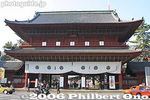
Sangedatsu-mon Gate (Sanmon) which is the temple's front gate. 三解脱門(三門)The main gate to enter the temple fronts a busy road. Important Cultural Property. "Sangedatsu" means to be released from the three earthly states of mind: greed, anger and stupidity. Walk through this gate and maybe this might happen to you.Feb 19, 2006
|
|
|
|
|
|